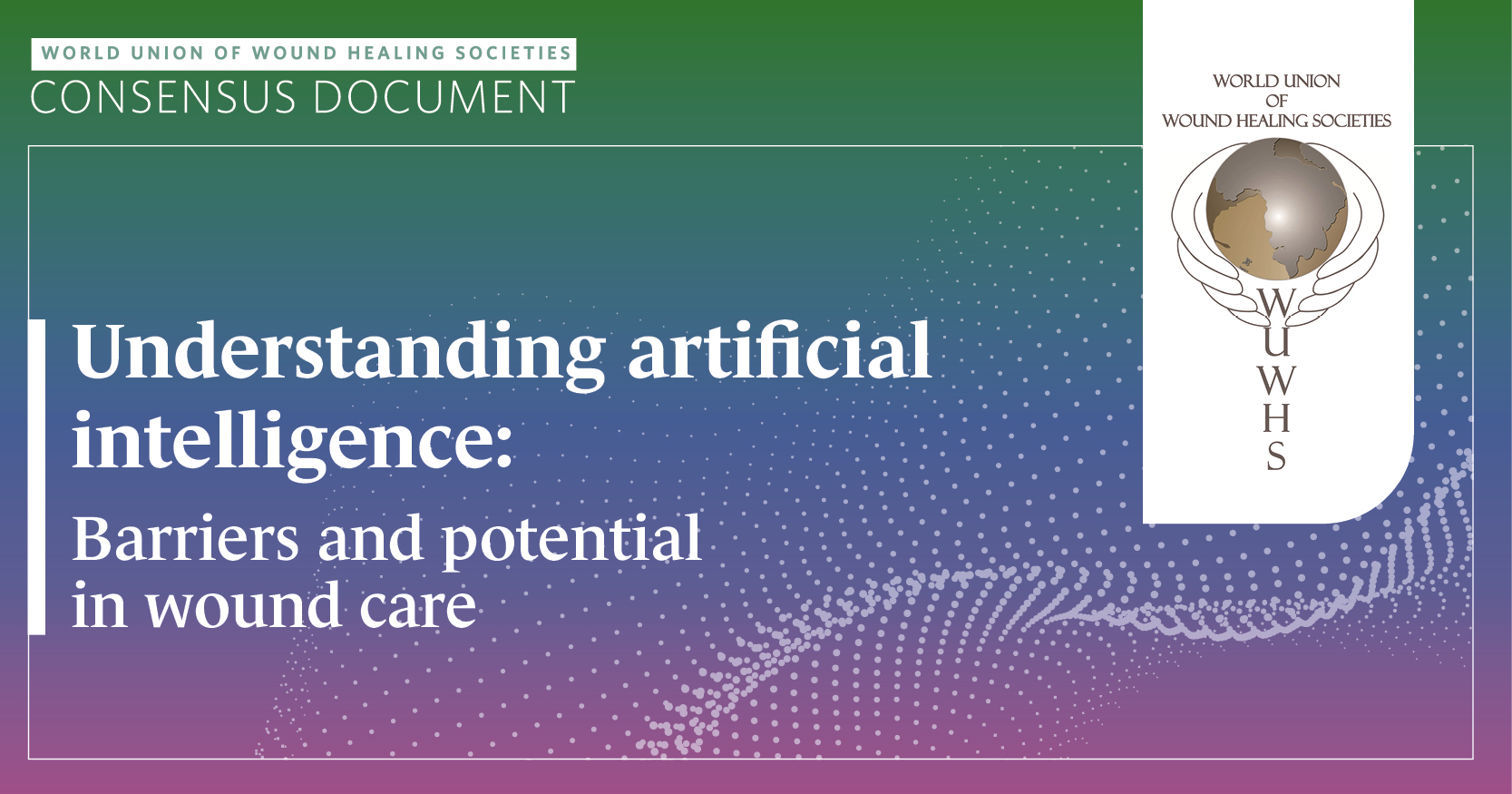Wound care has traditionally relied on empirical knowledge, clinician expertise, and manual assessments. However, technological advances in artificial intelligence (AI) and sensor technology are now revolutionising this field by offering the option for data-driven, real-time insights into wound healing processes and the associated wound care resources and costs. With the increasing prevalence of chronic wounds, driven by aging populations and the rise of diabetes and vascular diseases, there is an urgent need for innovative wound care solutions that improve healing outcomes while reducing the burden on healthcare systems. The wound care of the near future is expected to employ AI-powered technologies that enable real-time wound monitoring of the individual and comparisons of their wound healing progress to large databases and of similar clinical cases, more effectively than any human can possibly perform. By leveraging machine learning (ML) models trained on vast datasets of wound images and clinical records, AI is already improving wound diagnostics, predicting complications, and optimising dressing materials (Lustig et al, 2022; Dabas et al 2023, 2025).
Furthermore, the integration of AI with sensor-embedded ‘smart’ dressings will allow continuous, remote monitoring of wound healing, reducing the need for frequent hospital visits, together with automated collection of data on the wound over time, which is vital for effective clinical decision-making. There are many initiatives worldwide currently to develop smart wound dressings embedded with sensors that continuously measure key wound parameters, such as the wound temperature, pH, moisture level and exudate production rates and patterns. These smart dressings are aimed at facilitating remote wound monitoring, reducing the need for frequent clinic visits. This is particularly beneficial for patients with mobility limitations or those in rural areas with limited access to wound care specialists.
When these data are fed to an AI algorithm, it can compare the wound healing progress or lack of progress in the individual with historical data or similar cases, helping clinicians predict healing trajectories and make informed treatment decisions or changes in interventions such as type of dressing or dressing change protocol. This capability improves precision medicine in wound care, allowing for individualised treatment plans that maximise healing efficiency. For example, ML systems can recommend the most appropriate dressing type based on the evolving wound characteristics, such as changing to antimicrobial dressings when the sensor readings indicate growing likelihood for development of infection. Such alerts and indications should optimise clinician workload through automated assessments and remote monitoring.
Less discussed, but no less important, is the use of AI for designing better dressings, using materials that perform optimally in the aspects of fluid handling, mechanical interactions with the wound bed and skin and that adhere optimally. All of these advances are important in managing all wound types, but offer specific benefits for chronic wounds, such as pressure injuries and diabetic foot ulcers, where timely intervention can prevent complications. However, AI-powered dressing development is expected to be a disruptive technology in the dressing industry. This article focuses on the expected impact of AI-powered technologies in wound dressing development.
AI in wound dressing design and optimisation
Traditional wound dressing development involves extensive laboratory testing and clinical trials, which are time-consuming and costly (Gefen et al, 2023, 2024). New AI-powered modelling significantly accelerates this process by simulating dressing performance in virtual environments, such as from a fluid handling, adhesion or peeling, distortion of skin tissues at the border of the dressing, conformability or other aspects of mechanical performance (Gefen 2024). For example, in the aspect of fluid handling, ML algorithms can analyse vast datasets of wound exudate properties, including exudate levels, composition, temperature, and pH, to recommend optimal dressing materials and structures to absorb or retain these fluids.
Finite element (FE) modelling, when combined with AI, allows researchers to predict how dressings interact with wounds under different conditions through interactive simulations, before prototyping begins (Gefen 2024). These advances will reduce development costs and ultimately improve the clinical effectiveness of wound dressings.
A future advance in AI-powered dressing technology is the development of systems capable of producing personalised dressings in hospitals. These systems will analyse patient-specific data to generate customised dressings tailored to individual wound characteristics, by analysing wound images and patient health records, and feeding these data to AI-integrated 3D-printing systems to produce patient-specific dressings providing optimal moisture, pressure distribution and antimicrobial properties for the individual patient and wound.
While physical testing remains crucial in evaluating dressing performance, AI-powered automation can streamline and optimise these processes, reducing the number of experiments needed while improving accuracy. Traditionally, laboratory testing of wound dressings involves fluid absorption tests, adhesion assessments, mechanical conformability analyses, and antimicrobial efficacy evaluations. A wound dressing development environment that is AI-powered can be used to identify the most relevant parameters to test based on historical data, eliminating redundant trials and focusing only on high-impact variables. Additionally, AI-driven robotic laboratory systems can perform automated experimental set-ups, increasing throughput while ensuring consistency and reproducibility.
Moreover, AI-based image recognition and spectral analysis can enhance the interpretation of laboratory results. By analysing relevant image data such as microscopy images, spectroscopic data, or fluid absorption patterns, AI algorithms can quickly determine how different dressing materials interact with wounds under various conditions, considerably reducing the time required for manual analysis.
Computer simulations, particularly those based on FE modelling and computational fluid dynamics (CFD), are increasingly being used to model wound dressing interactions before manufacturing prototypes or for improving prototypes more effectively than if the development processes rely solely on experimentation. Computer FE/CFD simulations can predict how dressings behave under different physiological conditions without needing to simulate those in the real-world, thereby reducing reliance on expensive trial-and-error methods. If AI is integrated with FE/CFD then, for example, the AI-powered modelling can predict how dressings may conform to irregular wound surfaces, for an optimal fit, or the fluid absorption dynamics for a specific foam microarchitecture, optimising the material selection or manufacturing process.
Likewise, CFD integrated with AI can help simulate the movement of exudate within dressings under different clinical scenarios, such as if the dressing is applied vertically to the ground or subjected to external mechanical forces (e.g. compression therapy), allowing developers to refine absorption, retention, and evaporation rates before physical testing and pre-clinical trials.
Importantly, these AI-powered modelling methods can also detect unexpected performance issues, such as points of exudate leakage or mechanical failure of the dressing, loosening of the adhesion or over-adhesion, long before materials reach the clinical trial stage. By integrating machine learning (ML) models into simulation frameworks, these models can continuously improve their predictions based on experimental validation data. Over time, AI-driven simulations will become more accurate and predictive, reducing the need for repeated physical testing and accelerating the development cycle.
One of the most powerful benefits of AI integration is creation of a closed-loop feedback system that connects laboratory experiments, computer simulations, and real-world clinical outcomes. In the future, it is expected that each phase of development in this cycle will inform and optimise the next steps, progressively refining dressing performance with fewer physical trials. For example, a closed-loop feedback system can take the following form [Figure 1]:
- Step 1: AI-Guided initial simulations – a ML model generates a virtual dressing prototype and simulate its mechanical, chemical, and fluid handling performance.
- Step 2: Targeted laboratory validation – the AI identifies the most critical tests to perform in the laboratory based on the simulation results, eliminating unnecessary experiments and their costs.
- Step 3: AI-Based data analysis – the AI algorithms analyse laboratory results to refine material properties and optimise dressing designs.
- Step 4: Iterative refinement using simulation – data from laboratory tests are fed back into the AI-enhanced simulations, updating predictive models to improve dressing performance in the next design iteration.
- Step 5: Real-world testing and feedback – once optimised, AI can integrate real-world patient feedback and clinical trial data to further refine dressings for future iterations.
This closed-loop AI-driven approach will allow a wound dressing design to progressively improve with minimal resource expenditure, which should dramatically cut costs compared to traditional development pipelines which often contain a trial-and-error component. The ability to integrate AI/ML, with FE/CFD simulations, and laboratory experiments into a unified development cycle expands the research and development options beyond exclusive reliance on extensive traditional laboratory methods, clinical testing and in vivo trials. This will open new avenues for companies to bring innovative wound dressing technologies to market faster and at lower research and development costs, while not compromising on rigorous safety and efficacy standards. For healthcare providers, this would eventually mean more affordable and effective wound dressings, improved patient outcomes, and less dressing failures or complications.
Summary and conclusion
The integration of AI into wound dressing development represents a paradigm shift in wound care, fundamentally altering the way dressings are designed, tested and optimised. By leveraging AI-driven computational models, ML and automated laboratory analyses, researchers and manufacturers can dramatically accelerate the innovation cycle while reducing development costs. The use of AI in wound care has already demonstrated potential in automating diagnostics, predicting complications and personalising treatments. However, its role in dressing design and optimisation is expected to be a disruptive force that will redefine the industry.
One of the most significant advantages of AI-powered dressing development is the ability to create a closed-loop feedback system that integrates laboratory experiments, computer simulations, and real-world clinical data. This iterative approach allows for continuous refinement of dressing materials and structures, improving performance in terms of fluid handling, adhesion, mechanical stability, and antimicrobial effectiveness. AI-driven predictive modelling, combined with FE and CFD simulations, reduces reliance on trial-and-error methods, enabling precise control over dressing characteristics before they reach clinical trials. By simulating real-world wound conditions and optimising dressing properties computationally, manufacturers can ensure better patient outcomes while minimising costly experimental procedures.
Furthermore, AI-based automation in laboratory testing enhances reproducibility and efficiency, ensuring that new dressings undergo rigorous validation with fewer resources. High-throughput AI-powered robotic systems can conduct extensive material analyses, optimise dressing compositions, and interpret experimental results with unparalleled accuracy. These advances not only expedite regulatory approval processes, but also enable the rapid translation of laboratory discoveries into clinically viable products.
Looking ahead, the implementation of AI-integrated, patient-specific dressing solutions presents an exciting frontier. The development of AI-enhanced 3D-printing technologies could allow for the on-demand production of custom dressings tailored to individual wound characteristics, offering unprecedented personalisation in wound care. Such advances will be particularly beneficial in managing chronic wounds, where personalised interventions can significantly improve healing outcomes and reduce the burden on healthcare systems.
Despite these promising developments, challenges remain. The successful adoption of AI in wound dressing design requires robust interdisciplinary collaboration between bioengineers, clinicians, data scientists, and material scientists. Additionally, regulatory frameworks must adapt to accommodate AI-powered medical device development, ensuring safety and efficacy standards are met without stifling innovation. Ethical considerations regarding data privacy, algorithm transparency, and potential biases in AI models must also be addressed to foster trust and acceptance in clinical settings. In conclusion, the fusion of AI, computational modelling, and laboratory automation heralds a new era in wound dressing development. By intelligently guiding testing, optimising material properties, and accelerating research and development, AI-powered technologies have the potential to transform wound care, making it more precise, cost-effective, and patient-centric. As these innovations continue to evolve, they will play a pivotal role in improving wound healing and related quality of life outcomes, and reshaping the future of wound management.




